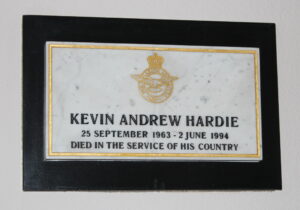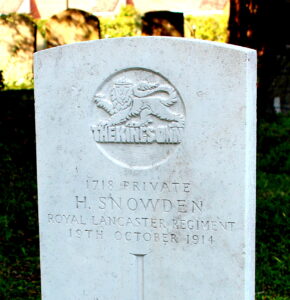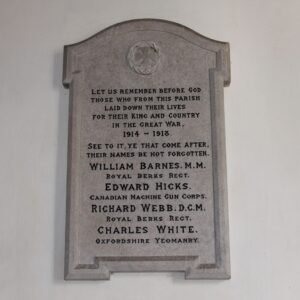Information about Grove
Other Casualties of conflict since World War II and Miscellaneous
Other members of the Armed Services who gave their lives for their country since World War II and other miscellaneous casualties of conflict
Kevin Andrew Hardie was born 25 September 1963 at Rutland Memorial Hospital, Oakham, Rutland, the son of Andrew Gentle and Hazel Dorothea (was Lindley, nee Wright) Hardie. He was described as a Senior Aircraftman serving in the Royal Air Force. He lived in one of the houses opposite the church and attended Millbrook Primary School, Grove. Kevin married Penelope Jane Birmingham on 1 October 1988 at Holy Trinity Church, Charlton, Wantage when he was living at 31 St Jones Court, Grove and she was living at 30 Hampden Road, Wantage.
Sergeant Kevin Andrew Hardie A8260280 7 Squadron RAF Odiham Royal Air Force died on 2 June 1994 a victim of the Chinook helicopter crash on the Mull of Kintyre.
On 2 June 1994 in the late afternoon Chonook Zulu Delta 576 was tasked to carry a group of 26 passengers from RAF Aldergrove, west of Belfast, to Fort George near Inverness. In the event only 25 passengers went on the flight. The crew of Zulu Delta 576 for the flight to Fort George were:
- Flight Lieutenant Tapper (Captain)
- Flight Lieutenant Cook (Co-pilot)
- Master Aircrew Forbes (Load Master)
- Sergeant Hardie (Crewman)
The details and inquiry into the crash are at http://publications.parliament.uk/pa/ld200102/ldselect/ldchin/25/25we21.htm
His remains are at the Park Crematorium, Aldershot, Hampshire.
According to Dick French, who was vicar at Grove at the time, the tablet bearing Kevin’s name was put up at the request of his parents and agreed by the Parochial Church Council. It is to be understood that the cost of the tablet was paid for by Kevin’s parents.

Miscellaneous
Harold Snowden Harold Snowden is buried in Grove churchyard but his name does not appear on the memorial plaques in the church.
Harold Snowden was probably born in 1894 in either Silsden or Keighley, Yorkshire, the son of Chalotte Annie Haytack (registration of birth not found) and probably William Snowden. The 1901 census shows him living with only his mother aged 7, and in the 1911 census ahed 17 when he was described as a labourer at a bobbin works. Before joining the Army in Morecombe, Lancashire he had been a bobbin-turner.
Harold Snowden joined the 5th Battalion King’s Own (Royal Lancaster Regiment) in June 1914, and when war broke out was sent south with his battalion to guard important points of communications such as bridges and railway junctions. In a letter to his mother dated 24 September he stated that one night he was nearly shot while on sentry duty. He challenged a man and was fired at but not struck. He blew his whistle, the guard turned out, and a man was captured. Maps and plans were found in his possession, and it was evident he intended doing something to the London main line.
1718 Private Snowden was killed by a train on Monday 19 October 1914 whilst guarding Green Land railway bridge 500 yards on the Wantage side of Lockinge signal box aged 19 or 20 (death certificate states 19). His address was given as 3 Chapel Street, Silsden, Keighley, Yorkshire. There was an inquest and full details given.
Harold is remembered on the Silsden War Memorial, the Silsden Roll of Honour and on the roll of Silsden Primitive Methodists.

Eric Percival Collingborn was born 4 March 1915 at Grove, the son of Percival John and Evelyn (nee West) Collingborn. He was described as a farmer. The family was still living in Grove in 1925 but had to move to Model Farm, Wokingham by 1931.
The Berkshire Herald reported that Sergeant Observer Eric P Collingborn was reported missing on 4 March 1941 (sic). He was a native of Grove and attended the local school being the eldest son of Mr Percival Collingborn of Manor Farm, Grove.
55 Squadron, Royal Air Force flew Blenheim IV’s, a long range fighter and maritime patrol aircraft with three crew. According to “Bomber losses in the NE and in North Africa, Blenheim IV Tango1995 took off at 0730 hrs from Marwa, Libya to reconnoitre the airfields at Sirte and Mechina (both in Libya). The aircraft was last seen by a Hurricane at 0800 hrs near Benina, 12 miles east of Benghazi. The other crew members were:
- Flying Officer Thornton Osborne Walker from New Zealand
- Sergeant Bernard Lee from Leeds
527299 Sergeant Eric Collingborn, 55 Squadron Royal Air Force died 19 March 1941 aged 26. He is remembered at the Alamein (Egypt) Memorial. No UK memorial has yet been found.
Richard Webb was born 12 July 1884 at Cumnor, Berkshire, the son of Thomas and Sarah (nee Hoare) Webb. He was described as a Labourer.
Richard was in the Metropolitan Police for a time before he re-joined the Army at the outbreak of the war. He married Marie Fenn on 25 December 1913 at St Stephens Church, Wandsworth when he was described as a Police Constable. His son, also Richard, was born in 1914 in Bromley, Kent, but during the war his wife and son moved to to Grove to live close to the family. His wife and son were living at 1 Council Houses (now 2 Station Road), Grove.
His sister Alice Sarah Webb married Stephen George Shaw and were living at Dixon’s Row, Main Street, Grove. According to relatives when the brother in laws left for France in September 1914 they made a pact between them as they each had one son that if one of them did not survive the war, the other one would look after the other family which happened as Richard Shaw died.
There was a small brass memorial urn in the old church in Grove, but this was returned to the family when the new church was built.
Richard Webb enlisted into the Army in 1916 joining the 8th Battalion Royal Berkshire Regiment and eventually rose to be a Warrant Officer Class II (Company Sergeant Major). He was awarded the Distinguished Conduct Medal (ranked 2nd to the Victoria Cross) for his gallantry during the German Spring Offensive in March 1918, his citation reads as follows:
“For conspicuous gallantry and devotion to duty during an advance. He kept his men in hand when help up by machine gun fire. After dark he went from shell-hole to shell-hole organising the defence and rallying many men from other units”. London Gazette 28 March 1918.
27221 Warrant Officer Class II (Company Sergeant Major) Richard Webb DCM, 8th Battalion Royal Berkshire Regiment was killed in action on 27 August 1918 aged 34 during the Hundred Days Offensive, the final advance of the Allied Armies during the war. He battalion was involved in heavy fighting over two days at Trones Wood on the Somme.
He is buried at Bernafay Wood British Cemetery, Mountauban (France) plot G11. Richard is remembered on the Besselsleigh War Memorial.

Bibliography
Aircraft Remembered
Commonwealth War Graves Commission
Faringdon Advertiser and Vale of White Horse Gazette
Grove Parish Council minutes
Grove Parochial Church Council minutes
Herald Series (North Berks Herald later Wantage/Abingdon Herald etc)
Kellys Directory 1939
North Wilts Herald
Reading Mercury
The Cambridge Dictionary of English place names – by Victor Watts 2010
The China Dragon Tales – The 1st Battalion Royal Berkshire Regiment in the great war by Ian Cull
The Fighting 10th A short history of the 10th Battalion Royal Berkshire Regiment 1940 – 1944 by David R C West
WWI War diaries held by the national Archives Kew
WW2 War diary transcripts for Royal Berkshire and Wiltshire Regiment
Vale and Downland Museum
Yorkshire Evening Post